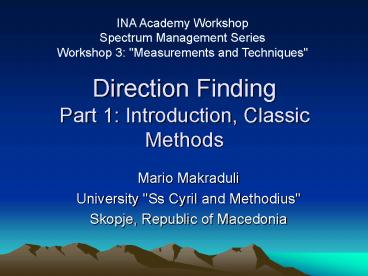Direction Finding Part 1: Introduction, Classic Methods - PowerPoint PPT Presentation
1 / 21
Title:
Direction Finding Part 1: Introduction, Classic Methods
Description:
CAPABILITY OVER THE FULL AZIMUTH RANGE. ADCOCK ANTENNA WITH WATSON-WATT EVALUATION ... AZIMUTH AND ELEVATION CALCULATION. Azimuth and antenna elevation ... – PowerPoint PPT presentation
Number of Views:4781
Avg rating:4.0/5.0
Title: Direction Finding Part 1: Introduction, Classic Methods
1
Direction FindingPart 1 Introduction, Classic
Methods
INA Academy Workshop Spectrum Management
Series Workshop 3 "Measurements and Techniques"
- Mario Makraduli
- University "Ss Cyril and Methodius"
- Skopje, Republic of Macedonia
2
RADIO DIRECTION FINDING APPLICATIONS
- Searching for interference sources
- Localization of non authorized transmitter
- Identification of transmitters, known and unknown
- Dealing with spread spectrum techniques,
specially in wireless communications - Military and security services
3
HISTORICAL DEVELOPMENTTRADITIONAL CONCEPT (1)
- The DF technique is as old as electromagnetic
waves are known - The first experiments of Heinrich Hertz in1888 in
decimetric waves give clear indication for
antenna directivity - The first patent for DF was proposed by Scheller
in1906 - In 1907 Bellini and Tosi proposed DF principle
based on combination of two crossed directional
antennas with a rotatable coil.
4
HISTORICAL DEVELOPMENTTRADITIONAL CONCEPT (2)
- In 1917 Adcock presented invention based on
vertical antennas rather then on antenna loops,
in this way horizontally polarized interfering
components are not picked up - In 1925/26 Sir Watson-Watt introduced electronic
visual direction finders, specially suitable in
shortwave range - In 1941 DF operating on the Doppler principle was
built, later in 1943 this systems operate at 3000
MHz
5
DEFINITION OF EMITTER DIRECTION
Reference direction
Transmitter
a
e
DF ANTENA
6
REFERENCE DIRECTION
Transmitter
North
True radio bearing
Dead ahead
DF Vehicle
7
PROPAGATION OF SPACE WAVES
8
DF USING DIRECTIONAL ANTENNA
BEARING INDICATOR
BEARING INDICATOR
RECEIVER
RECEIVER
IF WITHOUT AGC
9
DF USING SUM-DIFFERENCE METHOD
U S
UD
10
Watson-Watt DF PRINCIPLE
- This DF method is based on two directional
antennas pairs and one omnidirectional antenna - The response of the two pairs are proportional to
sine and cosine of the arrival signal. - Watson-Watt DF consists of three phase-matched
receivers and displays angle of arrival in terms
of sine and cosine functions utilizing third
omnidirectional channel to solve ambiguity. - Accuracy 1 -20
- Very short response time 1ms typically
11
MAIN FEATURES
- This system has drawbacks because requires
considerable amount of alignment. - Usually the picked signals are very weak and so
called integration time was inserted, realized
with low pass filters attached on the meter
outputs. - This technique is suitable up to 600 MHz, because
at higher frequencies other techniques are find
to be superior - Elevation calculation is not possible
12
WATSON-WATT DF WITH CROSSED LOOP ANTENNA
Brightness
DF converter
13
CALCULATION PRINCIPLE
BENEFITS UNDELAYED BEARING INDICATION AND
MONOPULSE CAPABILITY OVER THE FULL AZIMUTH
RANGE
14
ADCOCK ANTENNA WITH WATSON-WATT EVALUATION
15
WATSON-WATT DF MODERN CONCEPT OF EVALUATION
16
DOPPLER DF CONCEPT
Typically four to eight antennas are arranged in
a circular array and are RF combined in a way
that simulates rotation.
17
DOPPLER DIRECTION FINDER
- If antenna system rotates, the incoming signal
with frequency w0 is modulated with the rotating
frequency wr. - From the instantaneous amplitude frequency is
derived by differentiation
18
BEARING CALCULATION
19
INTERFEROMETER BASED DF
- This concept is based on phase measurement
between a subset of possible pairs of antennas
with minimum of two coherent receiver channels - Phase measurement for a specific pair can be used
for arrival angle determination, based on
knowledge of relative antenna distance - When more then one pair is used elevation
calculation is possible - Accuracy is about 10
- Response time 10 ms
20
3- ELEMENT INTERFEROMETER
l
l
a
a
e
a e
A e
21
AZIMUTH AND ELEVATION CALCULATION
Azimuth and antenna elevation determination is
possible if spacing between antennas is not
greater then half a wavelength. If three phases
are measured than the following calculation is
performed































